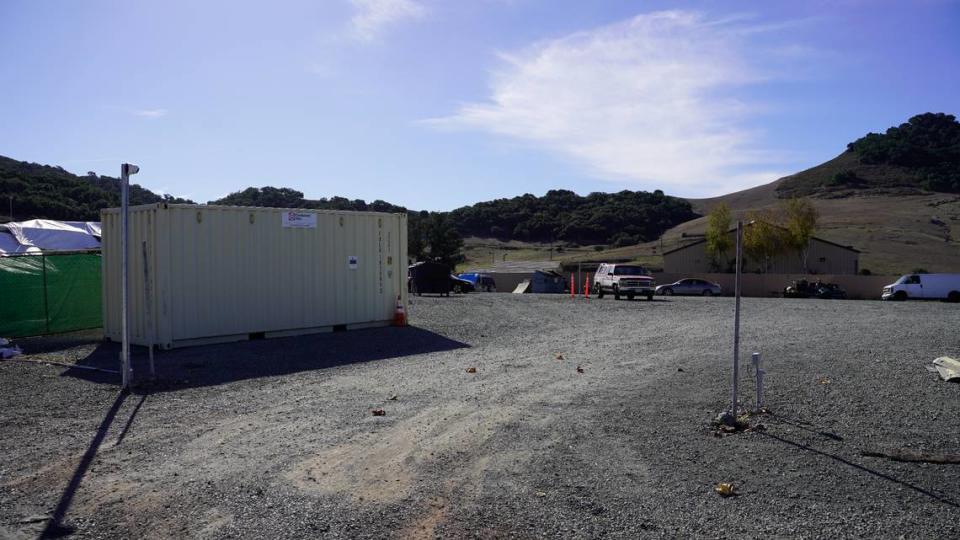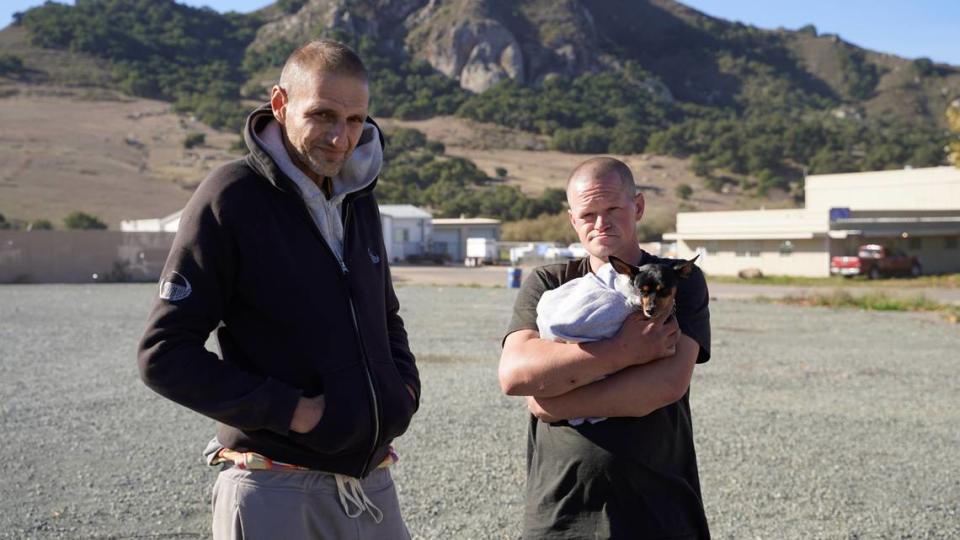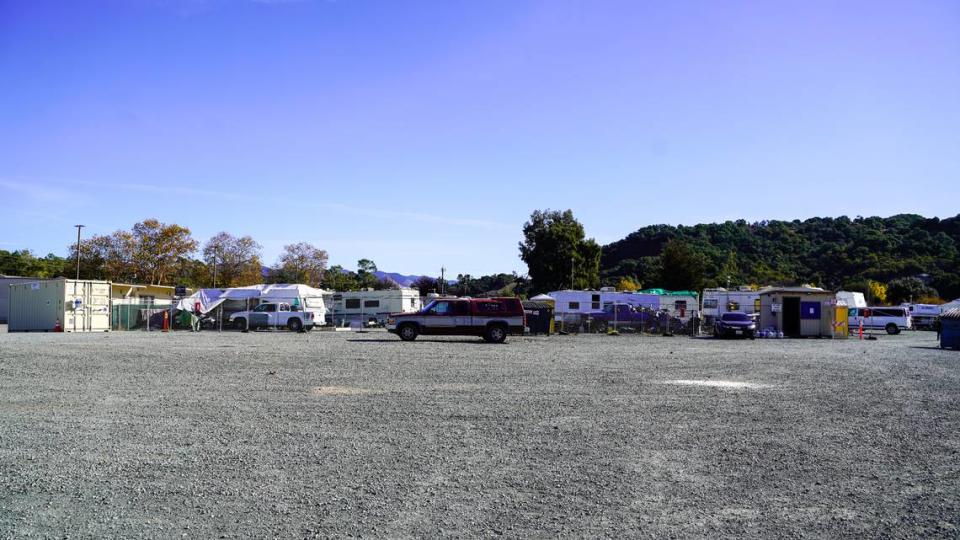SLO County safe parking residents say they face few options as Oklahoma Avenue closure looms
Support SLO County Housing Reporting
→ Support reporter John Lynch’s coverage of housing and homelessness in SLO County by donating to The Tribune’s Local Impact Journalism Fund. Go to sanluisobispo.com/donate.
When Mike first moved to the Oklahoma Avenue Safe Parking site two years ago, he saw it as a stepping stone to getting into housing.
Two years later, he’s facing the prospect of unsheltered homelessness for the first time — and it’s not for lack of trying.
Mike, who asked The Tribune to not disclose his last name for fear of retribution, moved to San Luis Obispo County from Stockton several years ago to work in a hotel, but was forced to turn to the parking site for shelter when he lost his housing due to what he said was an illegal eviction.
Living on the site the past two years, Mike said he’s maintained a job and improved his credit score while searching for housing opportunities, sometimes with the help of Community Action Partnership of San Luis Obispo case workers.
Now, after two years of searching “to no avail,” Mike is facing homelessness and potentially losing his job.
Mike said while there have been some benefits to staying on the parking site, including being able to pay off back taxes and improving his credit, it has cost him greatly.
“Everything that’s been printed in the paper now is a stigma against anybody that’s from (the parking site),” Mike said. “If you have to put down where you’ve lived the last few years and you put down here, they’re not going to rent you anything.”
He also said he hasn’t been offered any real housing solutions, even as the county has increased efforts to help relocate residents in recent months as the site prepares to close.
Mike said he’s afraid of facing the same situation as other residents who were told earlier this week to leave the site by Dec. 15 because they were not engaging with the housing placement process.
“I just want to get out and get a place, and I’ve told them that all along,” Mike said. “Whatever you guys set me up with, I’ll take.”

Why were more residents of SLO safe parking site asked to leave?
In this most recent round of removals, the county sent letters to seven individuals who did not pursue housing pathways “with the necessary level of diligence and cooperation,” according to the removal notice.
The county has asked people to leave the site more frequently in recent months, removing several residents in September for “repeated incidents and threats of violence” and rolling out a Relocation Assistance Program in October that offered residents $1,000 to move off the site with county assistance.
County Homeless Services Division communications manager Suzie Freeman said the seven residents who were most recently asked to leave were “strongly encouraged” to continue working with their case managers after they have left the site.
Residents who are asked to vacate the site because they did not accept relocation offers will be given the $1,000 and are entitled to the benefits the county promised in the Relocation Assistance Program, Freeman said.
Freeman said the residents who were asked to leave can also seek shelter at 40 Prado Homeless Services Center, which has made its 90-day transitional beds available to Oklahoma Avenue residents.
“The county has been openly talking about reducing the site and its eventual closure since earlier this year,” Freeman told The Tribune. “While every situation is different, people have been offered a wide range of options.”
Freeman said those options includelots in mobile home parks, affordable housing complexes and entry into “the very effective 90-day programs” at either 40 Prado or the El Camino Homeless Organization’s shelters.
When those options don’t work, the county also turns to more “creative options,” including reunification with family, out-of-county options or placement in work exchange programs, “but with any of these there ultimately needs to be cooperation from all parties involved to find success through any of these routes,” Freeman said.
As of Nov. 4, 95% of the site’s residents had accepted relocation aid, Freeman said. Many have moved out since, with the site’s population dropping from around 50 residents to 20 as of Friday, not including the seven who will leave next week.

Former Oklahoma Avenue residents say they have returned to homelessness
Since the Oct. 18 deadline to sign the Relocation Assistance Program paperwork, timelines to move out have shortened for many residents, leading to lost possessions, hasty exits and returns to homelessness, former residents told The Tribune.
Leon Shahoian and Tim McElroy’s year of staying on the site came to an early end in late November after first being told their deadline to leave was Jan. 15, Shahoian said.
It’s not clear why they were asked to leave early, or why they have not been able to retrieve their belongings, Shahoian said.
“We didn’t do anything wrong,” Shahoian said. “We were good people here — everyone knows that. We kept our place clean. I never had any complaints.”
Shahoian and McElroy lived in the trailers closest to the gate, but since leaving, the site has shrunk in size, with the front gate receding deep into the lot as recreational vehicles and campers are removed or emptied of their past occupants.
In an email to The Tribune, Freeman said that was done to reconfigure the site to meet fire safety recommendations made by the San Luis Obispo County fire marshal.
Vehicles are stored away from the site for 90 days after being left, Freeman said in the email.
Since being asked to leave, Shahoian, McElroy and McElroy’s dog, Marley, have been living in Santa Rosa Park in San Luis Obispo with very few of their possessions, Shahoian said, after taking what they could carry when they left and storing the rest in shipping containers on the parking site.
McElroy said other residents have taken their possessions from the containers while he and Shahoian were away from the site.
“All I’ve got is a backpack with some dog food in it and a pair of sweat bottoms,” McElroy said.
Freeman said the containers are used to hold possessions of people who have left the site for 90 days after they leave.
Meanwhile, living unsheltered again cost Shahoian his job at a nearby gas station, which he had been able to maintain while living on the parking site, he said.
Residents: Even with flaws, safe parking is better than street
Multiple other residents described similar housing situations after leaving the site, including difficulty in getting landlords to accept their applications, returns to homelessness, lost possessions and lingering illness after staying on the site.
Residents such as Shelley Elder, who lives with Mike, said they have experienced respiratory issues, hair loss and hives while staying at the Oklahoma Avenue site.
Elder said she was anxious about the proposition of going back to the street after a pair of relatively stable years, though she will be glad to be away from the site, which she believes is the cause of her health problems.
She and Mike don’t have an immediate deadline to move, but know it won’t be long until they’ll need a new spot to stay, Elder said.
While looking for a new place to set down in the meantime, Elder said she’s running into the same problems as Mike: There are no places in San Luis Obispo County for homeless people to stay and fewer for RV or trailer residents.
“We’re trying to get a place to put the trailer, and that is hard because (El Chorro Regional Campground) doesn’t want safe parking there,” Elder said. “They have blackballed safe parking — you can’t even say you’re from safe parking, because we’re like pariahs.”
Several residents interviewed by The Tribune said the housing options offered by case workers didn’t fit their needs, were insufficient or would not be a stable long-term outcome.
Naomi DeLeon was among the seven residents asked to leave or seek shelter at 40 Prado, and said she’s facing homelessness as a result.
DeLeon has lived on the parking site the past two years, looking to stabilize herself and find housing so she can care for her 8-year-old daughter again, who currently lives with DeLeon’s mother.
She said her situation has worsened considerably over those two years, and with her pending removal from the parking site, she can’t follow up on things she’s made progress on, such as starting the path to attending culinary school.
“At least here, I didn’t have to get harassed by the cops, and not worry about the trailer getting towed,” DeLeon said.

What’s next for Oklahoma Avenue Safe Parking?
Freeman said most of the remaining 20 individuals living on the parking site have set relocation exit dates through mid-January at the latest, but said the county still is not set on an exact closing date for the site.
In the meantime, residents who fail to leave the site by their assigned move-out dates will be considered trespassers on county property, Freeman said in an email.
Though many site residents expressed a desire to either stay or said they wanted the county to explore long-term campground or safe parking options, Freeman said the county is preparing for the site’s final months of operation.
“Our team is very ready to be putting its staff time and resources toward other programs and solutions that can more effectively solve homelessness,” Freeman said.

